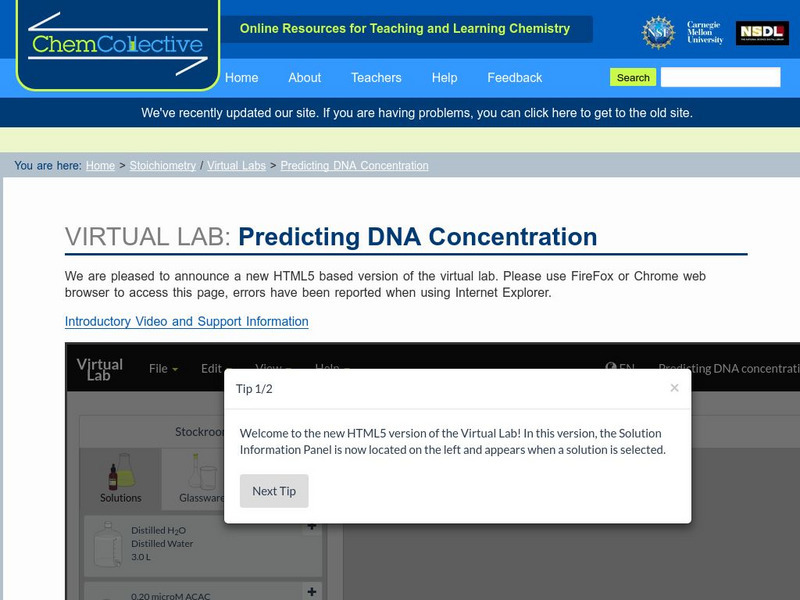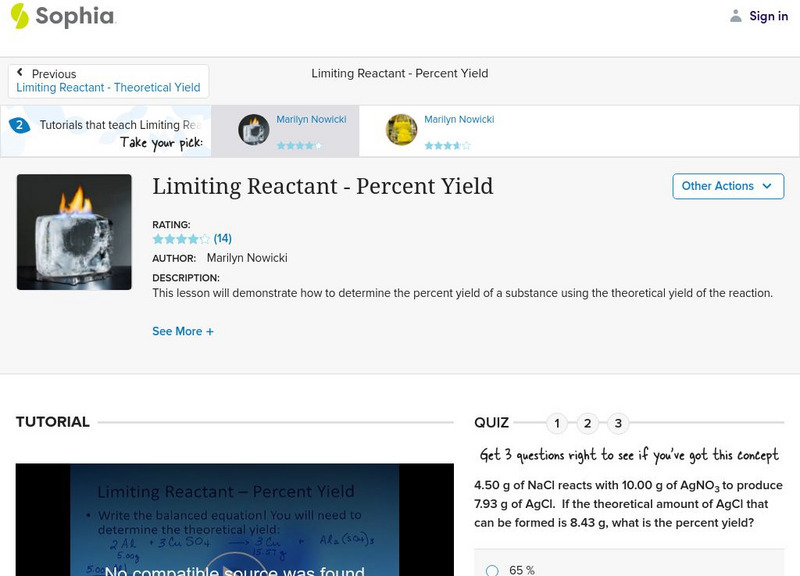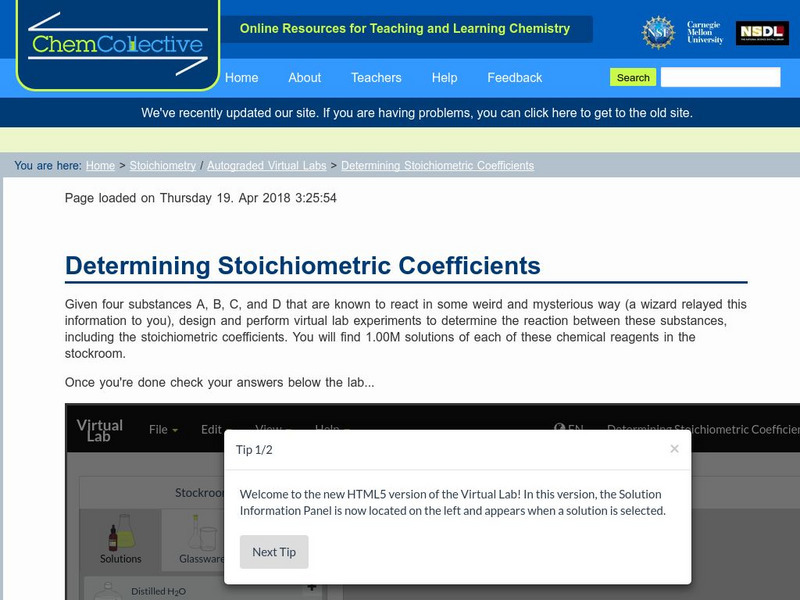Sophia Learning
Sophia: Limiting Reactant Theoretical Yield
Find out the procedure in determining the theoretical yield of a product in a chemical reaction. [6:25]
State University of New York
State University of New York: Limiting Reactants
This simulation explores the "limiting reactant" effect. The extent to which reactants that involve more than one reactant can produce products depends on the quantities of those reactants combined. In most cases, one reactant will be...
Alabama Learning Exchange
Alex: S'mores Limiting & Excess Reactants
Learners will use manipulatives that represent the ingredients for S'mores (graham crackers, marshmallows, chocolate bar) to determine the limiting and excess reactants (reagents) for making S'mores. The students will extend this to...
Frostburg State University
General Chemistry Online: The Mole Concept
Resource provides notes on Moles and Stoichiometry. Deals with all book-keeping aspects, including as section on yields and limiting reactants. Includes lesson plans, lecture slides and notes, links to related websites, and frequently...
Chemistry Collective
Chem Collective: Predicting Dna Concentration
In this limiting reagents problem, students are given specific concentrations of DNA solutions and are asked to predict what products and reactants will remain after a specific volumes are mixed and reaction has occurred.
CK-12 Foundation
Ck 12: Plix: Chemical Formulas and Symbols: Reactants and Products
[Free Registration/Login Required] Drag the atoms from the table to create chemical formulas. You will need a sign-in to access this media, but it will be well worth your time!
Sophia Learning
Sophia: Limiting Reactant Percent Yield: Lesson 1
This lesson will demonstrate how to determine the percent yield of a substance using the theoretical yield of the reaction. It is 1 of 2 in the series titled "Limiting Reactant - Percent Yield."
Simon Fraser University
Chem1 Virtual Textbook: Chemical Equations and Calculations
As part of the "Basic Atomics" section of the Virtual Textbook, chemical equations are examined here. Equations involving ions and limiting-reactant problems are also discussed.
Other
Widener University: Hints for Solving Stoichiometry Prob.
Great analogy if you are uncomfortable with the concept of limiting reactants. A great starting point. Finishes with chemistry.
Sophia Learning
Sophia: Limiting Reactant Percent Yield
A video lesson which explains how to determine the percent yield of a substance using the theoretical yield of the chemical reaction. [5:13]
American Chemical Society
Middle School Chemistry: Lesson Plans: What Is a Chemical Reaction?
After observing a demonstration of a chemical reaction between a burning candle and the oxygen in the air, young scholars use atom model cut-outs to model the reaction and see that all the atoms in the reactants show up in the products.
Concord Consortium
Concord Consortium: Stem Resources: Chemical Reactions
This web-based activity gives students an opportunity to write chemical reactions, balance chemical equations, and explain what is happening during a given chemical reaction. Also addressed is the effects of concentration and temperature...
CK-12 Foundation
Ck 12: Stoichiometric Calculations
[Free Registration/Login may be required to access all resource tools.] In the following online tutorial students will learn to calculate the amount in moles of a reactant or product from the mass of another reactant or product. They...
University of Oxford (UK)
University of Oxford: Named Organic Reactions: An Interactive Guide
Discover types of organic reactions. Explore by reactants and products. Use the interactive portion of this module to draw mechanisms associated with these reactions.
CK-12 Foundation
Ck 12: Mole Ratios
[Free Registration/Login may be required to access all resource tools.] In this learning module, students will learn how to calculate and account for the amounts of reactants and products in a given chemical reaction.
Concord Consortium
Concord Consortium: Chemical Reactions and Stoichiometry
In this activity, students explore reactions in which chemical bonds are formed and broken. Students experiment with changing the temperature and the concentration of the atoms in order to see how these affect reaction rates. They also...
Chemistry Collective
Chem Collective: Determining Stoichiometric Coefficients
Students use the virtual lab to determine how four unknown substances react with each other including their stoichiometric coefficients. In this randomized activity, each student receives a different reaction and students can check their...
Chiral Publishing
Chiral Publishing: An Introduction to Chemistry: Chemical Calculations and Chemical Equations [Pdf]
Slide show focusing on the elements of stoichiometry relating to limiting reactants. Go through the first several slides to review or introduce the topic.
Chemistry Collective
Chem Collective: Textbook Style Limiting Reagents Problems
Textbook-style practice limiting reagent exercises with that can be used as a way to "predict and check" your answers using the virtual lab.
Chemistry Collective
Chem Collective: Textbook Style Limiting Reagents Problem Ii
In this activity, students practice with experiments involving limiting reagents and the test their knowledge to determine the concentration of an unknown solution.
Science Education Resource Center at Carleton College
Serc: How Big Is the Balloon?
A chemistry lab where students investigate limiting reagents and balanced chemical equations. A simple experiment that gives students a physical example of what limiting reactant means.
Crescent Public Schools
The Internet Science Room: Stoichiometry
This chemistry tutorial presents Stoichiometry to students with explicit steps for solving a mass-mass problem and for solving a limiting reactant problem.
Concord Consortium
The Concord Consortium: Molecular Workbench: Seeing Chemical Equilibrium
Observe a visual representation of the equilibrium of products and reactants in chemical reactions. Record data while the reactions are taking place and print out a report afterwards.
Sophia Learning
Sophia: Changes in Concentration at Equilibrium
This lesson will provide examples of how to identify an equilibrium shift due to a change in concentration of either reactants or products.
Other popular searches
- Reactants and Products
- Limiting Reactants
- Chemistry Limiting Reactants
- Reactants of Photosynthesis
- Reactants With Vinegar
- Mass of Reactants
- Excess Reactants
- Introduction to Reactants
- Reactants of Equations




















